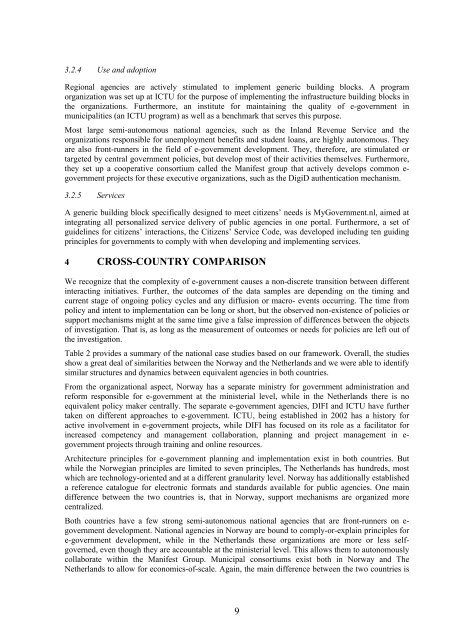Multi-channel provisioning of public services - Department of ...
Multi-channel provisioning of public services - Department of ...
Multi-channel provisioning of public services - Department of ...
You also want an ePaper? Increase the reach of your titles
YUMPU automatically turns print PDFs into web optimized ePapers that Google loves.
3.2.4 Use and adoption<br />
Regional agencies are actively stimulated to implement generic building blocks. A program<br />
organization was set up at ICTU for the purpose <strong>of</strong> implementing the infrastructure building blocks in<br />
the organizations. Furthermore, an institute for maintaining the quality <strong>of</strong> e-government in<br />
municipalities (an ICTU program) as well as a benchmark that serves this purpose.<br />
Most large semi-autonomous national agencies, such as the Inland Revenue Service and the<br />
organizations responsible for unemployment benefits and student loans, are highly autonomous. They<br />
are also front-runners in the field <strong>of</strong> e-government development. They, therefore, are stimulated or<br />
targeted by central government policies, but develop most <strong>of</strong> their activities themselves. Furthermore,<br />
they set up a cooperative consortium called the Manifest group that actively develops common e-<br />
government projects for these executive organizations, such as the DigiD authentication mechanism.<br />
3.2.5 Services<br />
A generic building block specifically designed to meet citizens’ needs is MyGovernment.nl, aimed at<br />
integrating all personalized service delivery <strong>of</strong> <strong>public</strong> agencies in one portal. Furthermore, a set <strong>of</strong><br />
guidelines for citizens’ interactions, the Citizens’ Service Code, was developed including ten guiding<br />
principles for governments to comply with when developing and implementing <strong>services</strong>.<br />
4 CROSS-COUNTRY COMPARISON<br />
We recognize that the complexity <strong>of</strong> e-government causes a non-discrete transition between different<br />
interacting initiatives. Further, the outcomes <strong>of</strong> the data samples are depending on the timing and<br />
current stage <strong>of</strong> ongoing policy cycles and any diffusion or macro- events occurring. The time from<br />
policy and intent to implementation can be long or short, but the observed non-existence <strong>of</strong> policies or<br />
support mechanisms might at the same time give a false impression <strong>of</strong> differences between the objects<br />
<strong>of</strong> investigation. That is, as long as the measurement <strong>of</strong> outcomes or needs for policies are left out <strong>of</strong><br />
the investigation.<br />
Table 2 provides a summary <strong>of</strong> the national case studies based on our framework. Overall, the studies<br />
show a great deal <strong>of</strong> similarities between the Norway and the Netherlands and we were able to identify<br />
similar structures and dynamics between equivalent agencies in both countries.<br />
From the organizational aspect, Norway has a separate ministry for government administration and<br />
reform responsible for e-government at the ministerial level, while in the Netherlands there is no<br />
equivalent policy maker centrally. The separate e-government agencies, DIFI and ICTU have further<br />
taken on different approaches to e-government. ICTU, being established in 2002 has a history for<br />
active involvement in e-government projects, while DIFI has focused on its role as a facilitator for<br />
increased competency and management collaboration, planning and project management in e-<br />
government projects through training and online resources.<br />
Architecture principles for e-government planning and implementation exist in both countries. But<br />
while the Norwegian principles are limited to seven principles, The Netherlands has hundreds, most<br />
which are technology-oriented and at a different granularity level. Norway has additionally established<br />
a reference catalogue for electronic formats and standards available for <strong>public</strong> agencies. One main<br />
difference between the two countries is, that in Norway, support mechanisms are organized more<br />
centralized.<br />
Both countries have a few strong semi-autonomous national agencies that are front-runners on e-<br />
government development. National agencies in Norway are bound to comply-or-explain principles for<br />
e-government development, while in the Netherlands these organizations are more or less selfgoverned,<br />
even though they are accountable at the ministerial level. This allows them to autonomously<br />
collaborate within the Manifest Group. Municipal consortiums exist both in Norway and The<br />
Netherlands to allow for economics-<strong>of</strong>-scale. Again, the main difference between the two countries is<br />
9
















